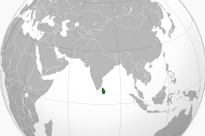The top story buzzing around the UN today the soon-to-be-released report on the failure to protect civilians caught in the final days of the Sri Lankan civil war. Parts of the report were already leaked to the BBC, and Ban Ki Moon is expected to make it public tomorrow. The short story is that there was a massive and system wide failure to prevent the slaughter of an estimated 40,000 ethnic Tamils in five short months in the winter and spring of 2009. (To put that in perspective, there has been an estimated 30,000 Syrians killed in over a year of violence.)
What we know about those final days is stunningly awful. This International Crisis Group report and this UN Commission of Inquiry report describe a months-long massacre of innocent civilians caught between Tamil Tiger insurgents on one side and government forces on the other. The insurgents used civilians as human shields, and the government decided to shoot through those shields to get to the Tigers. Hundreds of thousands of people were trapped in an area the size of Central Park, subjected to daily mortar fire and indiscriminate killing. The Sri Lankan government said they were going after terrorists. That may be true, but they did so by killing tens of thousands of civilians in the process.
The world’s response to this unfolding horror was muted — and continues to be. The report tomorrow should describe the UN’s response in detail–the early headline reads “system-wide failure.” But it is worth pointing out that the Sri Lankan military blocked access to the combat zone and made every effort to intimidate harass and threaten UN officials. There is a limit to what humanitarian aid workers can do to stop a government committed to committing atrocities, particularly when key governments around the world are not paying much attention. When Ban Ki Moon raised the prospect that war crimes had been committed and there should be some accountability, a government minister lead a riot that burned him in effigy.
Failure to respond to this crisis happened in Washington, DC, too. Anti-genocide groups that formed in the wake of the Darfur genocide did not rouse their constituencies around the mass atrocity in Sri Lanka. You barely heard from these groups, let alone see the kind of public awareness raising campaign that has made organizations like the Enough Project so effective in moving public opinion and shaping policy. At the time, the Enough Project was barely engaged, owing to its overriding focus on Africa. The institutional standard bearers of the anti-genocide movement failed to respond to the singly worst atrocity since Darfur.
So too did official Washington. This was the first mass atrocity event of the Obama era. At the time, the big response from the Washington was to temporarily block a World Bank loan package for Sri Lanka. Needless to say, that did not dissuade the Sri Lankan government from its killing spree. Three years later the White House launched a promising new Atrocities Prevention Board to streamline the US government’s response to genocide-like events, presumably like Sri Lanka. But in an indication of just how off-the-radar this tragedy is, three hours worth of panel discussions to mark the launch of the Atrocities Prevention Board neglected to even mention Sri Lanka.
The world failed Sri Lankan citizens caught in conflict four years ago. We should not compound this error by ignoring the tragedy today. In the coming days, we will learn in detail from a report commissioned by the Secretary General that takes a sharply critical look at the UN’s response to the Sri Lanka tragedy. That is a step forward, and progress toward avoiding repeating this failure. Anti-genocide constituencies around the world ought to also undertake the same hard-hitting self examination. You cannot profess to be anti-atrocity and ignore Sri Lanka.
